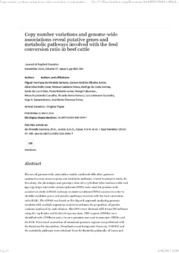Copy number variations and genome-wide associations reveal putative genes and metabolic pathways involved with the feed conversion ratio in beef cattle.
Copy number variations and genome-wide associations reveal putative genes and metabolic pathways involved with the feed conversion ratio in beef cattle.
Author(s): SANTANA, M. H. de A.; OLIVEIRA JUNIOR, G. A.; CESAR, A. S. M.; FREUA, M. C.; GOMES, R. da C.; SILVA, S. da L.; LEME, P. R.; FUKUMASU, H.; CARVALHO, M. E.; VENTURA, R. V.; COUTINHO, L. L.; KADARMIDEEN, H. N.; FERRAZ, J. B. S.
Summary: The use of genome-wide association results combined with other genomic approaches may uncover genes and metabolic pathways related to complex traits. In this study, the phenotypic and genotypic data of 1475 Nellore (Bos indicus) cattle and 941,033 single nucleotide polymorphisms (SNPs) were used for genome-wide association study (GWAS) and copy number variations (CNVs) analysis in order to identify candidate genes and putative pathways involved with the feed conversion ratio (FCR). The GWAS was based on the Bayes B approach analyzing genomic windows with multiple regression models to estimate the proportion of genetic variance explained by each window. The CNVs were detected with PennCNV software using the log R ratio and B allele frequency data. CNV regions (CNVRs) were identified with CNVRuler and a linear regression was used to associate CNVRs and the FCR. Functional annotation of associated genomic regions was performed with the Database for Annotation, Visualization and Integrated Discovery (DAVID) and the metabolic pathways were obtained from the Kyoto Encyclopedia of Genes and Genomes (KEGG). We showed five genomic windows distributed over chromosomes 4, 6, 7, 8, and 24 that explain 12 % of the total genetic variance for FCR, and detected 12 CNVRs (chromosomes 1, 5, 7, 10, and 12) significantly associated [false discovery rate (FDR) < 0.05] with the FCR. Significant genomic regions (GWAS and CNV) harbor candidate genes involved in pathways related to energetic, lipid, and protein metabolism. The metabolic pathways found in this study are related to processes directly connected to feed efficiency in beef cattle. It was observed that, even though different genomic regions and genes were found between the two approaches (GWAS and CNV), the metabolic processes covered were related to each other. Therefore, a combination of the approaches complement each other and lead to a better understanding of the FCR.
Publication year: 2016
Types of publication: Journal article
Unit: Embrapa Beef Cattle
Observation
Some of Embrapa's publications are published as ePub files. To read them, use or download one of the following free software options to your computer or mobile device. Android: Google Play Books; IOS: iBooks; Windows and Linux: Calibre.
Access other publications
Access the Agricultural Research Database (BDPA) to consult Embrapa's full library collection and records.
Visit Embrapa Bookstore to purchase books and other publications sold by Embrapa.

